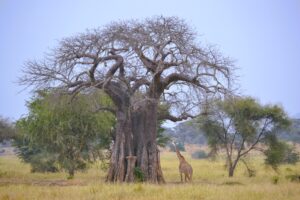
| Objective: Go on a safari in Tanzania Location: Serengeti, Ngorongoro, Tarangire Claim to Fame: Big Five, Great Migration |
An African safari is an adventure of a lifetime. In Tanzania, the best wildlife viewing areas are in the Serengeti, Ngorongoro Crater, and Tarangire. Discover the immense biodiversity in the East African bush on game drives through this ruggedly beautiful terrain. Thanks to safari guides and their incredible tracking skills, you will experience close encounters with wild animals. Observe how these majestic creatures really interact with each other when free to roam in their natural habitats. Sleeping under the stars to the tune of hyena laughter is the cherry on top!
Immerse yourself in local culture and traditions at a Maasai village. While you’re in Tanzania, you can also climb Kilimanjaro or visit the seaside in Zanzibar.
Serengeti | The Big Five | Ngorongoro Crater | Oldupai Gorge | Tarangire | Maasai Village | Tented Camp | Plan Your Visit | Photos
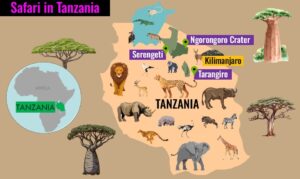
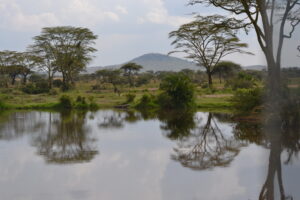
SERENGETI
| In the Maasai language, the Serengeti means “endless plains.” Indeed, it stretches across 5,700 square miles of plains, woodlands, and grasslands. |
The Serengeti is a tropical savanna with grasslands occasionally separated by kopjes (rocky hills). We drive over countless miles of muddy, rocky, and uneven terrain to track elusive wildlife. The truck goes up slopes, across shallow dung pools, and past tall grass fields. We go by fallen trunks, below acacia trees, down ravines, under storm clouds, and above flowing streams.
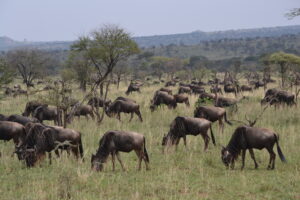
The Great Migration
The Great Migration is a continuous journey spanning 1,200 miles. Millions of wildebeests and zebras move in a clockwise circle from the Serengeti to the Maasai Mara for food and water. There are wildebeests as far as the eye can see. They run wildly in every direction. Some are fighting. Others make funny mooing and honking sounds.
Wildebeests and zebras are the best partners. Zebras have excellent vision. Wildebeests have a keen sense of smell. Together, they can sense danger from far away. Zebras eat the tops of grasses and wildebeests eat the bottoms of grasses.
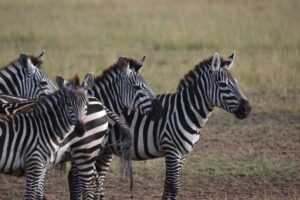
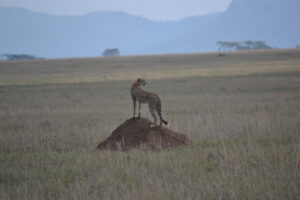
Close-up on Cheetahs
We see a cheetah’s head well camouflaged in the tall grass. The cheetah is sitting on a termite mound. A bolt of lightning strikes. An antelope leaps out of the grass and runs in a safe direction. As a result, we wait for the cheetah to chase after one of the gazelles or wildebeests.
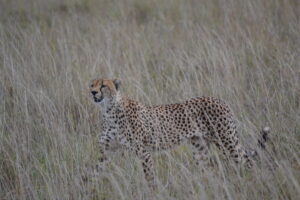
Then, the cheetah turns around and walks in our direction. After that, we spot another cheetah. Both cheetahs are now walking to our vehicles. One walks right past us to the sound of shutter clicks. The other one sits down right at the center of the trucks! Soon, these two rockstars return to the hill to continue stalking their prey.

Hippo Pond
At a large watering hole, there are dozens of hippos. This water will eventually lead to Lake Victoria and empty into the Nile Delta. It’s fun to watch hippos. Their ears flap like fast fairy wings. After an explosive hippo poop, their tails move like a windshield wiper.
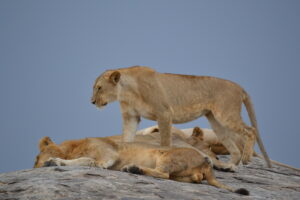
Lion Hill
As the sun’s gentle warmth melts away the morning’s dew, we approach Lion Hill. At the top of this kopje are three lionesses. An elder male is off to the side, about 100 meters, under a tree. A young male walks down the ridge with five other lions. A regal procession of lions evenly spaced apart has returned to the royal throne room. On the way to the top, a couple unambitious lions veer from the commotion to leisurely climb a leafless tree.
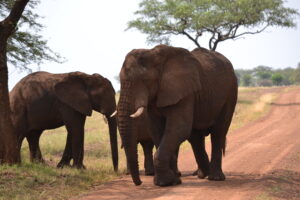
Elephant Encounter
We stumble upon dozens of elephants. After we park by the roadside, the elephants quickly surround us in every direction. To the left, to the right, in front of us, and in the distance – elephants everywhere! Elephants of all sizes – small, medium, large. The elders form a circle around the cute baby elephants.

The extra-large behemoths have ivory tusks longer and sharper than spears. The giants are feasting on the trees, snapping them to get to the good parts. They are annihilating and snapping the trees in half. The broken tree trunks reveal a milky color and damp sap. Nothing gets in the way of these powerful and determined beings. This constant consumption helps zebras and other plains animals by keeping the savanna clear. Plus, they probably need to eat so much since they only sleep two hours per day.
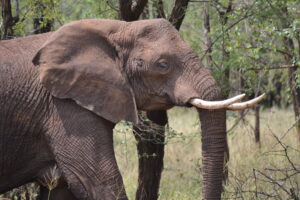
THE BIG FIVE
The Big Five is a collection of iconic megafauna that is a must see for safari-goers. What’s better than tracking these impressive creatures in their natural habitat?
| The Lion is an apex predator, but it lounges around most of the time. The lionesses do most of the hunting while the males defend the pride. | 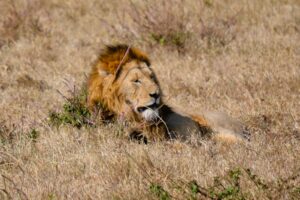 |
| The Elephant is the largest land animal and can drink two gallons through its trunk. Elephants are always eating. They devour leaves, fruits, bark, and even small branches. |  |
| The Cape Buffalo can’t regulate its temperature, so it grazes in the morning. They have an interesting helmet with two large, upward curving horns. | 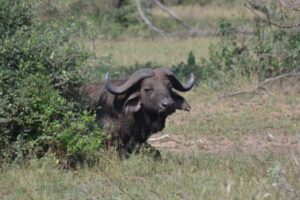 |
| The Rhinoceros is endangered due to poaching. The black rhino has a hooked lip and two horns. At Ngorongoro, we spot two black rhinos. Later, we spot another rhino munching on leafy plants. | 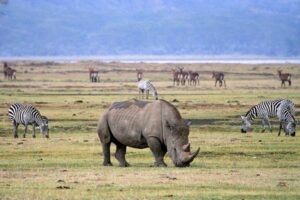 |
| The Leopard is a nocturnal predator that relies on speed, stealth, and climbing. We watch an elusive leopard on a branch. The leopard climbed the tree with a carcass in its teeth. Through the telephoto lens, you can even see its rings. |  |
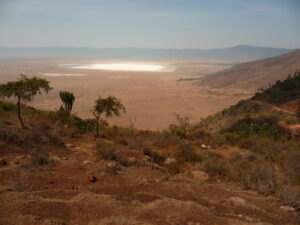
NGORONGORO CRATER
| Rising above the plains west of Arusha, this World Heritage Site is a sanctuary for enormous wildlife. |
The Ngorongoro Crater is the largest, intact, inactive, and unfilled caldera in the world. Many qualifiers, but this was once a volcano as tall as Kilimanjaro that erupted and then collapsed on itself. The caldera is 11.8 miles wide with walls that rise 2,001 feet high.
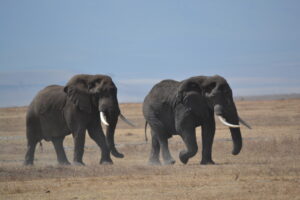
The caldera’s high walls have isolated the animals from the outside world. With ample water from springs and streams from the crater rim runoff, the wildlife here has grown large and abundant. The animals have everything they need here. This is the place to see the largest lions and tuskers. One large male lion jumps over a river, climbs a hill, and immediately finds a spot to rest.
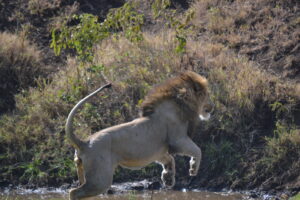
This is one of the last places where black rhinos thrive in the wild. We are fortunate to see three of them from afar.
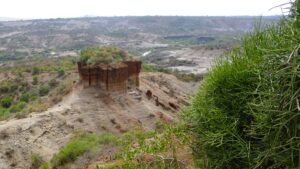
OLDUPAI GORGE IS A CRADLE OF LIFE
| In 1959, scientists found the oldest known human remains in Oldupai Gorge at the eastern area of the Serengeti. |
Mary and Louis Leakey found important hominid fossils at Oldupai Gorge. The fossil evidence showed that various hominid species occupied the area for three million years.
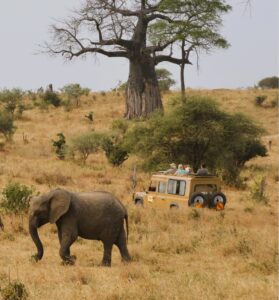
TARANGIRE
| Tarangire is Tanzania’s third largest national park. Colossal baobab trees dominate the landscape by the Tarangire River valley. |
We set off from Arusha in three Land Cruisers. The sturdy vehicles have 4-wheel drive, spare tires, and spare fuel tanks. At Tarangire, the guides pop the tops off the trucks. It helps us to see and take better photos. There’s a morning game drive and a late afternoon game drive to avoid the midday sun. Our guide, Eki, expertly tracks the flora and fauna and communicates with other teams.
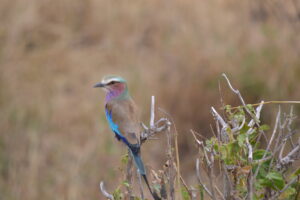
Tarangire has the second-highest concentration of wildlife in Tanzania’s park system (after the Serengeti). It borders the East African Rift Valley and contains grasslands, woodlands, and river gulleys.
Thorny acacia trees and tall termite mounds cover the landscape. The giant baobab trees are the highlight of Tarangire. They reach 100 feet tall with massive bottle-shaped trunks.
Common wildlife found in Tarangire include: zebras, giraffes, buffaloes, dik diks, impalas, elands, Grant’s gazelles, vervet monkeys, mongooses, and olive baboons.
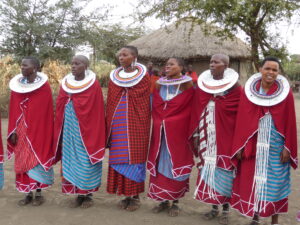
MAASAI VILLAGE
| Immerse yourself in the culture of the Maasai, a semi-nomadic group in northern Tanzania and southern Kenya. These warriors and cattle herders still practice their traditional way of life. |
At a Maasai village, the village leader greets us while holding a stick. Around the bomas (huts), a parade of Maasai women sings to us. They wear fabrics of varying shades of red. Heavy ornaments have stretched some of their earlobes. They wear donut-shaped, beaded bangles around their necks. The villagers invite us to sing and dance. I slump my shoulders and start leaping vertically with the line of warriors next to me.

The village puts us to work. They instruct the women how to thatch the rooftops of the bomas. Then men learn how to pound maize with a big stick.
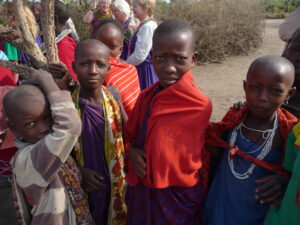
I show a group of children a camera with pictures of them. One kid looks at my hair. Soon, many little hands are massaging the top of head!
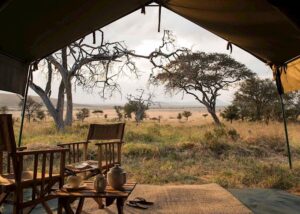
TENTED CAMP
Deep in the bush, the team has set up our camp in a semicircle with no fences. The tents are in the heart of the savanna and animals can walk right next to the canvas. During the night, we hear hyenas whooping and laughing. However, this is posh living in the outdoors. Each tent has its own shower, toilet, bedroom, and changing room. What’s better than a warm shower after a long day in the field? Also, every room has a zipper. This compartmentalization prevents snakes from entering the tent. They tell us to check the toilet for snakes before sitting down.
Above all, the luxury extends to the incredible local meals. At the dining tent, we start with Ugali (polenta) and Kachumbari (tomatoes, onions, cucumber, peppers). In addition, we try Ndizi Nyama (plantain and beef) and Kuku Paka (chicken in coconut sauce). Lastly, we enjoy sundowners with the setting sun.
PLAN YOUR VISIT
| Vendor: Overseas Adventure Travel Location: Serengeti, Ngorongoro, Tarangire Transportation: 3 Toyota Land Cruisers Lodging: Olasiti Lodge, Arusha Tented Camp, Lake Burunge Tented Camp, Serengeti Health: Yellow Fever vaccine, malaria pills Days: 13 Group Size: Up to 16 |
PHOTOS
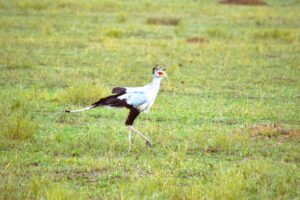
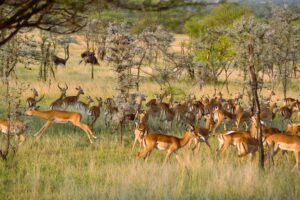
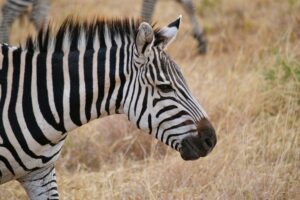
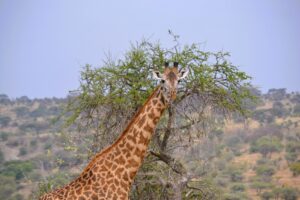
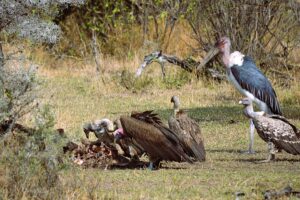
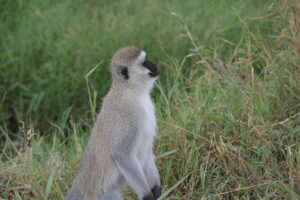
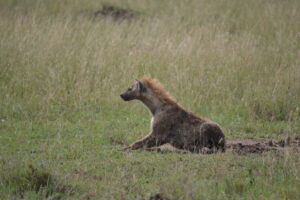
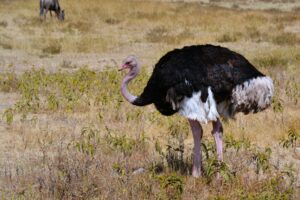
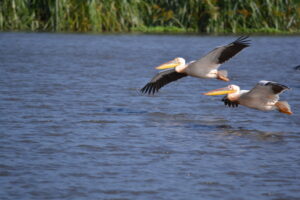

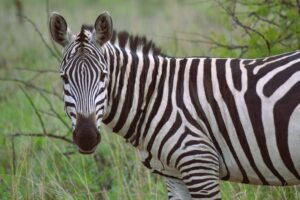
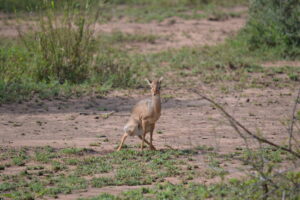
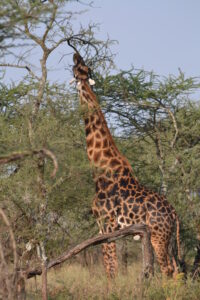
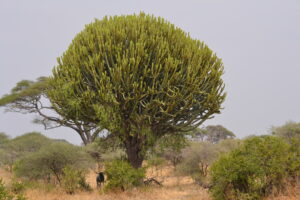
Keep Exploring!
While you are in Tanzania, consider trekking to the roof of Africa. During a climb to Kilimanjaro, the terrain changes from rainforest to shrubs, then rises from alpine desert to arctic peak. After you summit, reward yourself with a safari.